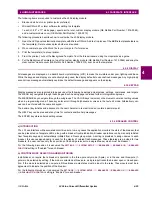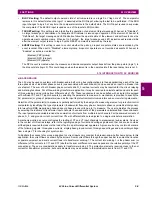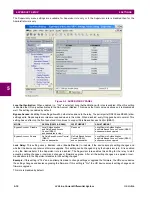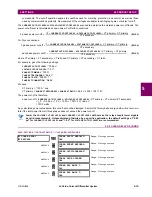
5-4
L30 Line Current Differential System
GE Multilin
5.1 OVERVIEW
5 SETTINGS
5
5.1.2 INTRODUCTION TO ELEMENTS
In the design of UR relays, the term
element
is used to describe a feature that is based around a comparator. The compar-
ator is provided with an input (or set of inputs) that is tested against a programmed setting (or group of settings) to deter-
mine if the input is within the defined range that will set the output to logic 1, also referred to as
setting the flag
. A single
comparator may make multiple tests and provide multiple outputs; for example, the time overcurrent comparator sets a
pickup flag when the current input is above the setting and sets an operate flag when the input current has been at a level
above the pickup setting for the time specified by the time-current curve settings. All comparators use analog parameter
actual values as the input.
The exception to the above rule are the digital elements, which use logic states as inputs.
Elements are arranged into two classes,
grouped
and
control
. Each element classed as a grouped element is provided with
six alternate sets of settings, in setting groups numbered 1 through 6. The performance of a grouped element is defined by
the setting group that is active at a given time. The performance of a control element is independent of the selected active
setting group.
The main characteristics of an element are shown on the element logic diagram. This includes the inputs, settings, fixed
logic, and the output operands generated (abbreviations used on scheme logic diagrams are defined in Appendix F).
Some settings for current and voltage elements are specified in per-unit (pu) calculated quantities:
pu quantity
= (actual quantity) / (base quantity)
For current elements, the
base quantity
is the nominal secondary or primary current of the CT.
Where the current source is the sum of two CTs with different ratios, the base quantity will be the common secondary or pri-
mary current to which the sum is scaled (that is, normalized to the larger of the two rated CT inputs). For example, if CT1 =
300 / 5 A and CT2 = 100 / 5 A, then in order to sum these, CT2 is scaled to the CT1 ratio. In this case, the base quantity will
be 5 A secondary or 300 A primary.
For voltage elements the base quantity is the nominal primary voltage of the protected system which corresponds (based
on VT ratio and connection) to secondary VT voltage applied to the relay.
For example, on a system with a 13.8 kV nominal primary voltage and with 14400:120 V delta-connected VTs, the second-
ary nominal voltage (1 pu) would be:
(EQ 5.1)
For wye-connected VTs, the secondary nominal voltage (1 pu) would be:
(EQ 5.2)
Many settings are common to most elements and are discussed below:
•
FUNCTION setting:
This setting programs the element to be operational when selected as “Enabled”. The factory
default is “Disabled”. Once programmed to “Enabled”, any element associated with the function becomes active and all
options become available.
•
NAME setting:
This setting is used to uniquely identify the element.
•
SOURCE setting:
This setting is used to select the parameter or set of parameters to be monitored.
•
PICKUP setting:
For simple elements, this setting is used to program the level of the measured parameter above or
below which the pickup state is established. In more complex elements, a set of settings may be provided to define the
range of the measured parameters which will cause the element to pickup.
•
PICKUP DELAY setting:
This setting sets a time-delay-on-pickup, or on-delay, for the duration between the pickup
and operate output states.
•
RESET DELAY setting:
This setting is used to set a time-delay-on-dropout, or off-delay, for the duration between the
Operate output state and the return to logic 0 after the input transits outside the defined pickup range.
NOTE
13800
14400
----------------
120
115 V
=
13800
14400
----------------
120
3
----------
66.4 V
=
Summary of Contents for L30
Page 10: ...x L30 Line Current Differential System GE Multilin TABLE OF CONTENTS ...
Page 30: ...1 20 L30 Line Current Differential System GE Multilin 1 5 USING THE RELAY 1 GETTING STARTED 1 ...
Page 370: ...5 244 L30 Line Current Differential System GE Multilin 5 10 TESTING 5 SETTINGS 5 ...
Page 464: ...A 10 L30 Line Current Differential System GE Multilin A 1 PARAMETER LISTS APPENDIX A A ...
Page 600: ...C 30 L30 Line Current Differential System GE Multilin C 7 LOGICAL NODES APPENDIX C C ...
Page 610: ...D 10 L30 Line Current Differential System GE Multilin D 1 IEC 60870 5 104 APPENDIX D D ...
Page 622: ...E 12 L30 Line Current Differential System GE Multilin E 2 DNP POINT LISTS APPENDIX E E ...
Page 634: ...F 12 L30 Line Current Differential System GE Multilin F 3 WARRANTY APPENDIX F F ...
Page 644: ...x L30 Line Current Differential System GE Multilin INDEX ...









































